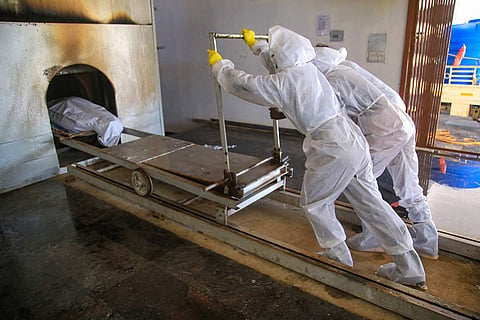

Policy, political interference and inconsistency in testing in the second wave may have resulted in a large number of COVID-19 deaths in Bengaluru compared to the neighbouring metropolitan city of Chennai, according to a study by Project Jeevan Raksha, a public-private initiative of management consulting firm Proxima Consulting and non-profit organisation Public Health Foundation of India (PHFI). As per the analysis, between two megacities, Bengaluru and Chennai, the difference in the COVID-19 death toll is massive. The team, which studies the COVID-19 trends, analysed the data from both cities for a 90-day period — between February 25 and May 25, 2021 — and found that the death reported in Bengaluru was over three times more than the deaths recorded in Chennai.
The study noted that the onset of the second wave was in early March 2021 and in the span of 90 days, 7,397 people died in Bengaluru Urban due to COVID-19, while in Chennai, 2,401 people succumbed to the disease. The 90-day mortality growth rate (MGR) of Bengaluru is 166%, whereas, in Chennai, it is 58%. “Higher MGR indicates a faster doubling period of deaths or that the average daily deaths are relatively more or increasing. Bengaluru saw a high number of deaths even though the average daily tests were around 45,000, whereas, in Chennai, the average number of daily tests was around 30,000,” the study noted.
The study also noted that the daily case fatality rate (percentage of deaths per 100 cases) in Bengaluru had increased up to 5.6% in the week between May 22 and 29 at a time when the COVID-19 cases showed signs of dipping. In the preceding year, when the first wave was receding, it was only up to 2% in October 2020.
Sanjeev Mysore, MD of Proxima and the convenor of the study, noted that the number of tests in Bengaluru has been consistent during the peak period of first and second waves, even though the spike was way larger in the second wave. “There was no corresponding increase in the number of tests even though the peak was 5,000+ in the first wave and more than 26,000 cases in the second wave,” he said.
| Comparative Analysis of Bengaluru and Chennai: Neighbouring Mega Cities: Huge Difference in Performance Level | ||||||
|---|---|---|---|---|---|---|
| Bengaluru Urban | Chennai | |||||
| Positive Cases | Active Cases | Deaths | Positive Cases | Active Cases | Deaths | |
| 25-Feb | 404628 | 3887 | 4466 | 235005 | 1780 | 4145 |
| 25-Mar | 422859 | 12472 | 4569 | 243954 | 4085 | 4215 |
| 25-Apr | 653656 | 180542 | 5800 | 309899 | 31538 | 4564 |
| 25-May | 1131496 | 219551 | 11863 | 487691 | 47553 | 6546 |
| March: 30-Day MGR | 5 | 221 | 2 | 4 | 129 | 2 |
| April: 30-Day MGR | 55 | 1348 | 27 | 27 | 672 | 8 |
| May: 25-Day MGR | 73 | 22 | 105 | 57 | 51 | 43 |
| 90-Day: MGR | 180 | 5548 | 166 | 108 | 2572 | 58 |
| Incremental Actual Numbers | 726868 | 215664 | 7397 | 252686 | 45773 | 2401 |
| Due to: Inadequate, Slow, and Low Testing | Due to: Adequate, Quality, and Timely Testing | |||||
| Policy: Flip-flop with RT-PCR and RAT | Policy: 100% RT-PCR | |||||
| Politics in Decision Making: High | Politics in Decision Making: Low |
Since the beginning of April, Bengaluru has been seeing a massive surge in deaths. Officially, 1,907 COVID-19 fatalities have been recorded in Bengaluru in April 2021 alone. The number of deaths due to COVID-19 rose to 6,360 in May (till May 29). The number of such deaths for the months of March, February and January was 147, 88 and 66 respectively. Until April, September 2020 recorded the highest number of COVID-19 deaths, at 971.
Unlike Bengaluru, Chennai has been consistently and solely relying on RT-PCR tests, giving them reliable results. Sanjeev also noted that interference of influential politicians in daily matters in Bengaluru had detrimental effects on the entire functioning of the administration. “Further, the rush to discharge patients and the lack of strict protocol to monitor patients in home isolation have also led to a spike in deaths in Bengaluru,” he added.
Bengaluru is still struggling to have a clear strategy for both containment and clinical management, he said. “Additionally, crucial decisions related to the quantum of testing are largely political rather than scientific. To worsen the situation, the political establishment in the state has a tendency to wash its dirty linen in public in order to gain electoral gain at the cost of morale of administrative staff members, who are working round the clock to solve the crisis,” added Sanjeev.
“Also, in one instance, an IAS officer has been physically abused, which is not acceptable under any situation. When the two key institutions — political and administrative — have to work in at most cordial ecosystem with mutual respect and trust, they are at loggerhead. This cost the lives of 5,000 more people in Bengaluru Urban in the second wave when compared to Chennai,” he noted.
*All data charts prepared by Jeevan Raksha